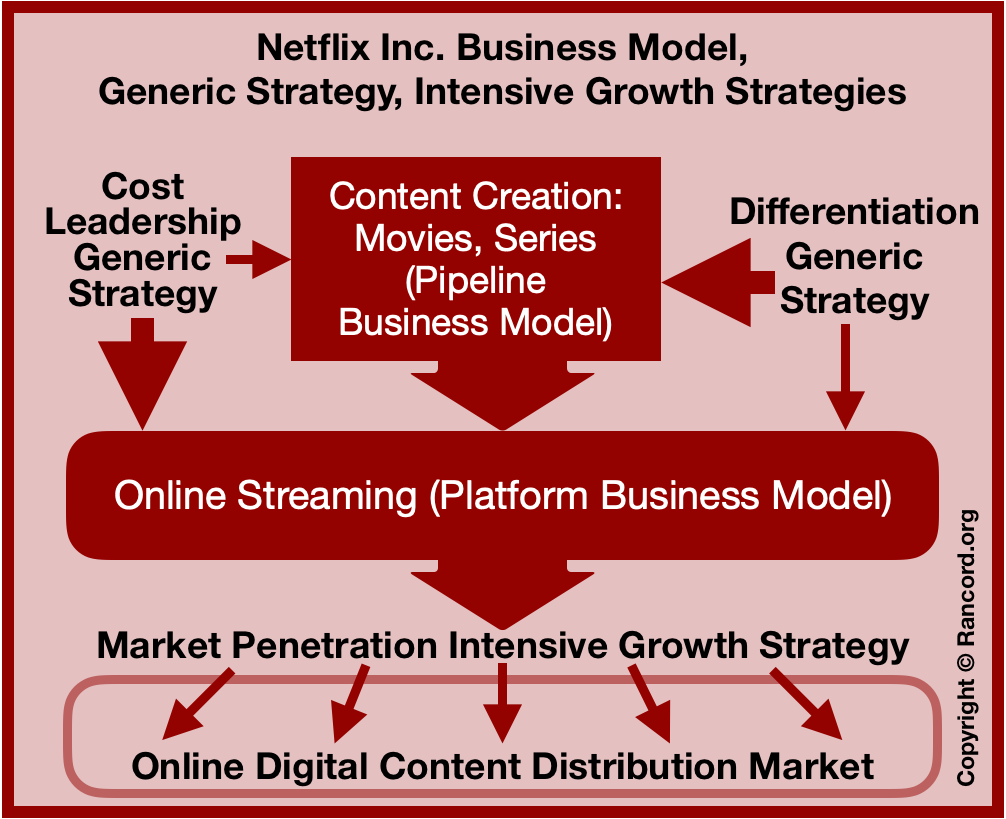
Netflix Inc.’s business model aligns with the company’s generic strategy for competitive advantage (Porter’s model), and intensive growth strategies (Ansoff Matrix). This alignment is seen as a factor in the company’s strategic position as a leading competitor in the on-demand digital content streaming industry. Netflix’s case is somehow comparable to that of Spotify’s business model, generic strategy, and intensive growth strategies, although there are differences in terms of product characteristics, competitive advantages, and how the business operates in providing streaming services. The platform business model defines both of these online companies’ operations. However, instead of focusing on music, Netflix Inc. focuses on movies and series, and the production of original content. Moreover, the company’s business model also involves a flat-rate subscription revenue model, in the absence of advertising within the streaming platform. Furthermore, Netflix’s intensive growth strategies and generic strategy for competitive advantage require management initiatives that extent beyond streaming operations.
Netflix’s generic strategy ensures that its business model works through suitable competitive advantages. The company’s business design and competitive position counteracts external forces involving Walmart, Amazon, Google, Apple, HBO, Disney, and other firms. Netflix’s intensive growth strategies promote business development while these competitive forces are addressed. Alignment of these growth strategies with the generic strategy and business model ensures the operational effectiveness and benefits of the corporation’s competitive advantages.
Netflix’s Business Model & Design
Netflix Inc.’s overall business model is a hybrid of various business models. This hybrid organizational system is due to the company’s operations involving on-demand streaming of entertainment content, and the production of original content, such as movies and series. In line with the corporation’s generic strategy for competitive advantage, these business models determine Netflix’s value chain and the associated competitive advantages based on the VRIN/VRIO analysis framework. The company is a strong example of how online business modeling provides the capability for large-scale high-efficiency operations, while minimizing costs. Netflix’s operations exhibit the following business models:
- Platform (digital media marketplace) and Pipeline (entertainment content production, etc.) business models
- Cutting-out-the-middleman business model (production to distribution)
- Unlimited subscription business model (revenue model for unlimited online access)
Pipeline and Platform Business Models. Netflix Inc. mainly has a platform business model for its online streaming operations. Through the company’s platform, which is filtered to some extent, content producers reach consumers. Consumers access their preferred entertainment content through the same platform. It is in the platform business model that Netflix’s generic strategy is most significant, considering the competitive advantages based on cost efficiencies possible through information technologies for global digital content distribution. On the other hand, the pipeline business model applies to the company’s content production operations. For example, through its generic strategy, Netflix Inc. uses the traditional pipeline approach to create new movies and series. The pipeline business model enables the company to control content production in a straightforward approach, while the business growth potential via the platform business model supports Netflix’s intensive growth strategies and generic strategy for competitive advantage.
Cutting-Out-The-Middleman Business Model. Netflix Inc. bypasses middlemen or intermediaries by directly distributing its original content to customers via its own streaming service. The company uses its competitive advantages and capabilities to apply this business model. For example, the platform’s large scale enables Netflix to efficiently distribute its original content to members. Such efficient capability links to the online company’s efforts in implementing its generic strategy. Also in this business model, other entertainment content producers can directly transact with Netflix to reach target audiences around the world, thereby supporting the company’s intensive growth strategies. Along with the generic strategy, this situation eliminates some intermediaries or middlemen that are traditionally involved in the distribution, sales, and marketing in the entertainment industry.
Unlimited Subscription Business Model. Netflix’s organizational design involves unlimited subscription, which is actually a revenue model that characterizes the company’s overall business model. In unlimited subscription, customers have unlimited access to entertainment content on the platform. This unlimited nature is a result of Netflix’s cost minimization efforts, in connection to the enterprise’s generic strategy for competitive advantage. For example, the corporation relies on cost efficiencies to ensure profitability despite such unlimited subscription offer. This revenue model helps attract and retain customers, and increases the success rates of Netflix’s intensive growth strategies.
Netflix’s Generic Competitive Strategy
Cost Leadership. Netflix Inc.’s generic strategy is cost leadership, which in Michael E. Porter’s model ensures competitive advantage through minimized costs and, frequently, minimized selling prices. This generic strategy enables the online entertainment company’s business model’s competitiveness based on low costs and the corresponding ability to sell at affordable prices, without necessarily being a best-cost provider. In this generic strategy, Netflix broadly acquires more customers in the online entertainment market, in contrast to focus strategies that concentrate on specific market segments. For example, the media streaming company uses its competitive advantages to reach more customers in the international market. This broad approach of the generic strategy aligns with Netflix’s intensive growth strategies, which prioritize market penetration. The approach relies on the company’s business model and value chain, which satisfy customers partly through personalized customizations, such as in mobile app settings. Through intensive growth strategies, the cost leadership generic strategy for competitive advantage gains the biggest market share, relating to Netflix Inc.’s corporate mission and vision statements, which point to the strategic plan and goal of attaining and maintaining leadership in the international online entertainment industry.
Differentiation. Even though Netflix mainly applies cost leadership as its generic strategy for competitive advantage, the business also uses differentiation in its operations. As a generic strategy, differentiation involves developing the online business and its products in ways that make them different from the competition. For example, Netflix develops its competitive advantage by producing its own original content, aside from streaming content from third parties. The differentiation generic strategy enables the business model to attract and retain customers, thereby supporting intensive growth strategies for further expansion of the online operations.
Netflix’s Intensive Growth Strategies
Market Penetration is the main intensive growth strategy of Netflix Inc. in expanding its business operations and multinational market reach. In the Ansoff Matrix, this growth strategy involves selling more of the online company’s streaming services in the markets that the business already has. This growth strategy’s objective of growing revenues and market share depends on how Netflix’s generic strategy maintains competitive advantages to gain and retain more customers in current markets. Other strategic areas also influence how the generic strategy and intensive growth strategies are applied as part of the online business model. For example, Netflix Inc.’s marketing mix or 4Ps defines the business strategies and tactics used for market penetration. Moreover, in using this intensive growth strategy, the corporation strengthens its business to successfully penetrate digital content streaming markets despite competitive rivalry. The business strengths discussed in the SWOT analysis of Netflix Inc. are factors for such strengthening of overall competitive advantage.
Market Development supports Netflix’s organizational development, but only as a secondary intensive growth strategy. Market development works by selling the company’s current online streaming service and original content to new markets. For example, in applying this growth strategy, one of Netflix’s goals is to grow the business by entering more countries, which serve as new markets. The company’s cost leadership generic strategy contributes to the success of this intensive growth strategy by making the online service attractive on the basis of price affordability. Competitive advantages are essential in making Netflix’s business model effective in generating profits in these new markets.
Product Development is another secondary intensive growth strategy that supports Netflix’s development and expansion. According to Igor Ansoff, this growth strategy’s objective is to develop and sell new products in the online company’s current markets. For example, Netflix uses its generic strategy for competitive advantage to efficiently produce new content for current subscribers, whose time spent watching such content adds to the company’s profits. This support for new entertainment content production is part of the pipeline business model within the company’s overall business model. Success in the product development intensive growth strategy depends on how Netflix Inc.’s organizational culture supports relevant product innovation processes.
Diversification is rarely applied to grow Netflix’s operations, arguably because of the high risks involved in this strategic direction. This intensive growth strategy’s goal is to grow the business through new operations outside the company’s current business of online streaming and original content production. This growth is possible through Netflix’s generic strategy and the business model’s capacity for new operations. Considering its competitive advantages, the enterprise is likely to focus on businesses or industries related to online media streaming when applying this intensive growth strategy. The functional changes involving this growth strategy could require new components in Netflix Inc.’s organizational structure.

Strategic Implications of Netflix’s Generic Strategy, Intensive Growth Strategies, and Business Model
Netflix’s generic strategy focuses on maximizing the competitive advantages of high operational efficiencies and cost effectiveness of information technologies. The company’s intensive growth strategies require aggressive marketing to expand multinational streaming operations. These corporate strategies are based on Netflix’s business model, where cost minimization and market penetration are supported. The online company’s business framework implies strategic management support for information technologies for efficient operations and global expansion. Netflix Inc.’s operations management implements these strategic implications, ensuring that all areas of operations are aligned to strengthen the business model and generic strategy for competitive advantage, and to support the intensive growth strategies.
References
- Adner, R., Ruiz-Aliseda, F., & Zemsky, P. (2016). Breaking Trade-Offs: When is Dominating from the Middle a Winning Generic Strategy? In Academy of Management Proceedings (Vol. 2016, No. 1, p. 16580). Briarcliff Manor, NY 10510: Academy of Management.
- Hussain, S., Khattak, J., Rizwan, A., & Latif, A. (2014). Interactive effects of Ansoff growth strategies and market environment on firm’s growth. British Journal of Business and Management Research, 1(2), 68-78.
- International Trade Administration of the U.S. Department of Commerce – The Media and Entertainment Industry in the United States.
- International Trade Administration of the U.S. Department of Commerce – The Software and Information Technology Services Industry in the United States.
- Netflix Inc. – Investors – Long-Term View.
- Netflix Inc.’s Annual Report to the U.S. Securities and Exchange Commission (Form 10-K).
- Netflix Inc.’s Website.
- Pauwels, K., & Weiss, A. (2008). Moving from free to fee: How online firms market to change their business model successfully. Journal of Marketing, 72(3), 14-31.
- Sakellaridis, K., & Stiakakis, E. (2011). Business model change due to ICT integration: An application to the entertainment industry. International Journal of Computer Information Systems and Industrial Management Applications, 3, 1-13.
- Spry, A., & Lukas, B. A. (2016). Brand Portfolio Architecture and Firm Performance: The Moderating Impact of Generic Strategy. In Looking Forward, Looking Back: Drawing on the Past to Shape the Future of Marketing (pp. 866-867). Springer, Cham.
